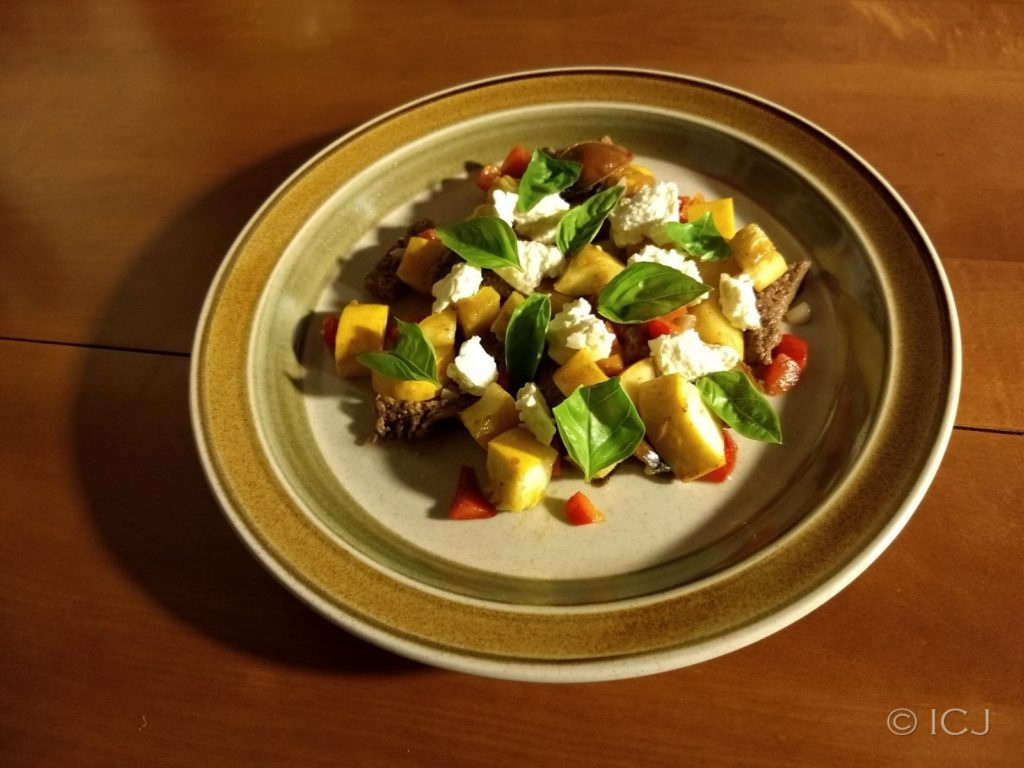Ashes to Watermelon
A maple tree that had grown on the ridge south of the creek heated my cabin for the first half of the winter last year. It showed up in pieces in the back of a white pickup several days after I messaged a local seller on OfferUp. It had stood for perhaps 30 years rooted somewhere between 1,000 and 2,000 ft of elevation, looking out over the valley I call home, gradually being relegated to the understory by towering conifers.
When the unit it occupied got clear cut, the timber of commercial value rattled down the hill on the backs of U-shaped cradle trucks and barreled around the bend in the narrow winding backroad past the gravel easement that leads to my land, clearly in a hurry to be transformed into lumber and what we still out of habit call telephone poles. The maple lay where it fell until an enterprising and burly young man, son and grandson of loggers, armed with chainsaw, axe and a permit for gleaning firewood from the carnage left on BLM land, spent his morning cutting it into rounds and splitting it for me.
My second load of firewood for the winter—a full cord this time—was also maple. It arrived just in time, a few days before a storm that brought 14” of snow and a windy night with a low of 19°F. The previous seller had dropped off the map and the next internet person I booked stood me up a week after I called him. Plenty of downed wood here but all of it wet and half green. My mechanic referred his wife’s cousin for the job.
Great-grandson of one of the founding fathers of Mossyrock, he now resides on 40 acres which has been in the family for a century or more. His lot is a subdivision of a much larger parcel purchased for an impossibly small sum of money by today’s reckoning. Firewood is a side gig. He does some permit-harvesting up in the hills but most he collects by selectively logging his land. This maple stood taller than a man before young Mr. Woods was a twinkle in his mother’s eye. Perhaps as a child he climbed it or dug for earthworms in its shade. There are all kinds of roots around here.
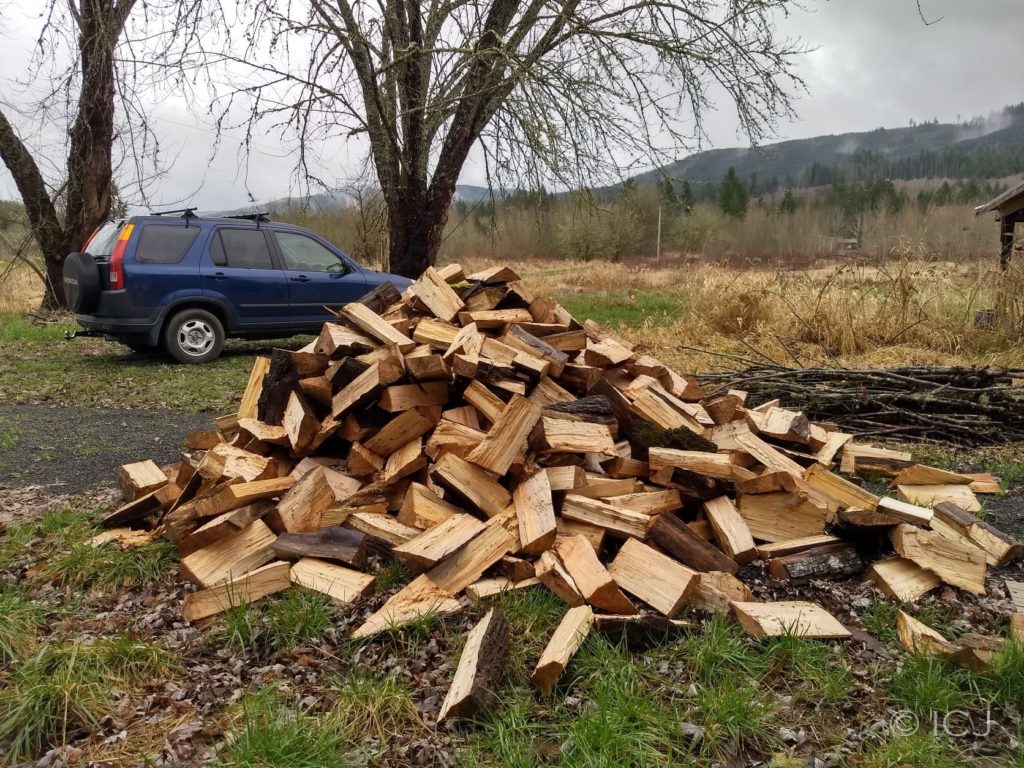
About once a week, afternoon when the embers have fully died from the morning’s fire, I empty the ashes into a bucket. Tree dust. All of the non-combustible content left behind. Cellulose and other hydrocarbons (C?H?) + oxygen (O2) –> carbon dioxide (CO2) + water (H2O). Exothermic reaction, meaning the energy stored in chemical bonds gets released as heat. Combustion. Poof! Out the chimney. Encapsulated sunlight that landed on maple leaves over the course of most of my lifetime radiates into the room.
What remains amounts to a natural mineral supplement for the garden, concentrated micronutrients in readily bioavailable form, procured without artificial chemical processing or mining. Calcium carbonate, potash (potassium), phosphate (phosphorus), iron, manganese, boron, magnesium, sodium, copper, and zinc are the more prevalent or important ones. Wood ash can be used like lime to increase the pH (=reduce the acidity) of soil, but with all the aforementioned advantages over lime.
Wood ash is more bioavailable, more minerally complex, and moreover is a byproduct of something you are already importing and would otherwise have to dispose of so is energetically and financially free. Because of its pH implications it must be used sparingly and only in areas where the acidity of the soil is too much for one’s desired crops to thrive. Easy to overcorrect if you pile it on.
Internet experts specialize in being vague and disagreeing. After some research in various quarters I settled on an application rate of 1 gallon: 100 sq ft (= 1 c / 6 sq ft). If an area needs more correction, better to apply more times a year than more at once so that it can gradually work its way in. Dust the soil using a plastic measuring cup for a scoop. Let rain, earth worms, pill bugs, and mycorrhizae do their thing.
Watermelons originated in Africa. Who knew? Not I until the watermelon I harvested August 1 turned out albino in what should be a red-fleshed variety and I started googling to find out why. Turns out, watermelons are not only drought-tolerant but drought-preferring once established. Rather counterintuitive for a fruit whose name is half ‘water’ and which is more than half water on the inside. Makes sense that it evolved in a region that has two seasons: rainy and dry.
Its wild ancestors survive untended in the desert. It was domesticated several thousand years ago and spread across the continent enough that archaeologists cannot agree whether the plant as we know it emerged in South Africa, Sudan, or around Egypt and Libya. A picture of one appears in an Egyptian tomb from 4,000 years ago. Trade introduced the watermelon to the Mediterranean around 2,000 years ago. All we know is that this summer picnic staple was brought to you by generations of inspired human attention before the institution of the alphabet and that they get around.
A watermelon is an oasis in a ball. Few things are more refreshing than a watermelon on a hot summer afternoon even when one has an endless supply of cool well water on tap. Imagine if you lived somewhere that the creeks dried up seasonally, the rains did not fall for months, where you might have to walk an hour to a well or half a day to a lake and carry back all your drinking, cooking, and bathing water on your head. Only once every 10 days would you have to share with the vine, while for weeks in the hottest, driest part of the summer the vine held the water and sweetened it, wrapped up in a sturdy green rind, packaged in a way that did not readily invite insects and did not spill. What a treasure a watermelon would be for you!
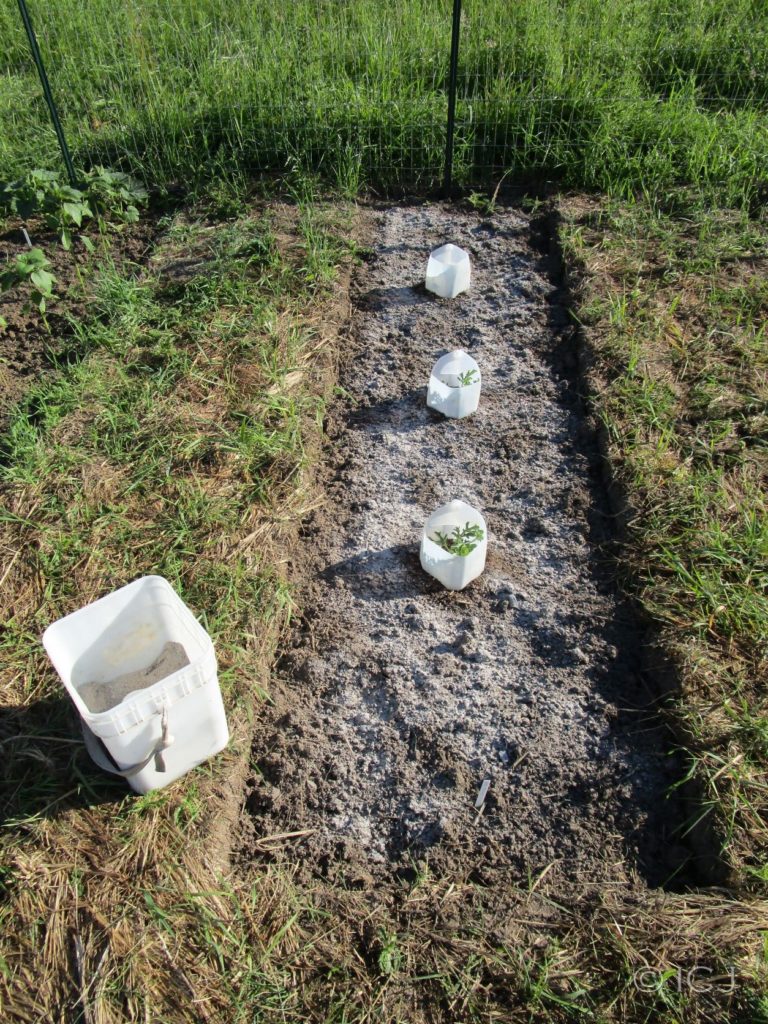
I ordered my ‘Blacktail Mountain’ watermelon seeds from Uprising, a small PNW seed company specializing in heirloom varieties suited to a temperate maritime climate. This variety of watermelon is ideal because they are small enough to fully ripen in our [historically] short warm season and because at 2.5-4 lbs they are manageable for eating without waste when one lives alone and only had a mini-fridge to keep leftovers in. This year I got four fruits off of three vines between August 1 and September 15, all softball-to-volleyball sized.
The first one, though white-fleshed (indicating overwatered and/or slightly underripe) was still quite crisp and sweet and flavorful. That vine bloomed again shortly after and managed to size up a second melon that matured before our first very early hard freeze September 16. The second one on the same vine was red and not as sweet as the first.

I planted this year’s watermelon seeds in the greenhouse April 27. The starts went outside and into the ground June 15, later than necessary based on frost but I was behind schedule clearing the turf off the new garden beds due to soggy weather and life. The third watermelon to ripen, the 4-pounder—definitely the best watermelon I ever had. It shimmered in your mouth. Sweet without being syrupy, and just so much flavor. I had cut back on the watering a few weeks before. Nature had not been watering for several months. Now I know.
Next year I’ll plant the watermelon seeds closer to April 15 and get them in the ground June 1 unless we are scheduled for even crazier late spring cold. (Last frost May 29 this year!) Maybe with the extra head start the vines will get strong enough that they can support more than one fruit at a time (they had plenty of blooms, and 3-6 bitty melons apiece that sized up enough to show they were pollinated before yellowing and dropping off), or at least all have time for a second fruit.
Last year I bought watermelon starts from a nursery. They were already pot-bound and stressed. Mice got one of the four before I figured out about the milk carton collars. Planted in the ground around the same time, the vines did not do anything but stay green until sometime in August. They then grew 2-3 feet long and put on one fruit apiece. Two reached baseball-sized and one almost attained softball but they stopped enlarging before our first hard frost in October, at which point I brought them in. Sugar Baby is supposed to be a dwarf variety but not *that* dwarf. The Internet says they can reach 8 lbs. The October watermelons were edible but not impressive for any reason other than being an October watermelon. Rough start in life (never really overcame the stunting from pot stress), less compost applied later in the season (I had just started my compost pile in April of 2020), and no ash.
Less compost later and no ash means fewer nutrients in the soil. No ash means more acidic soil means harder for most plants to take up the nutrients that are there. Too many variables to pin the relative success of this year’s watermelon to any one factor but I daresay the application of a little tree dust served them well.
All of the melons, squash, and cucumber did much better this year than last. Most of last year’s in absence of a proper greenhouse I had planted from seed in early June directly in the ground.
Bits of calcium and iron that were the maple that warmed my house last winter before feeding the watermelon are in my blood and bones. Perhaps a few molecules of that tree line the retinas on which the late afternoon October light imprints the raw beauty of the southern ridge where the maple used to stand. (Potassium? Copper? What are eyes made of, anyway?) These mysterious and highly specialized arrays of cells, not caring where their components were scavenged from, cooperate with the mysterious and highly improbable terms of biochemistry and physics by conjuring up an image in my brain.
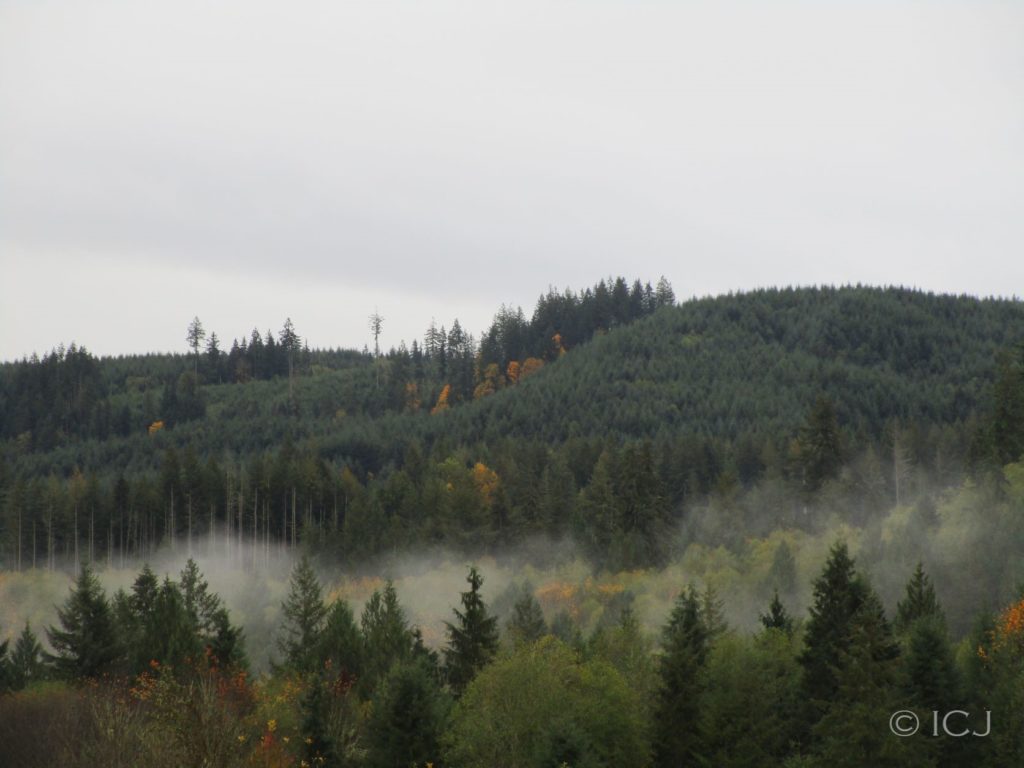
Other particles from the tree dust are scurrying around as pill bugs or resting in the frost-withered vines until I get around to cleaning up that garden bed and composting them.
The carbon dioxide that flew up the chimney makes the atmosphere ever-more-dangerously insulating, though some of it will be breathed in by the leaves or needles on the ridges above me to become future timber and firewood, fresh oxygen breathed out in return. The water vapor in the wood smoke joins the mist floating up from the creek and the clouds that blow in from the ocean before falling as precipitation further east. The hydrogen atoms that held the maple aloft and the oxygen from the wooded hills that settled on the valley on a cold winter night joined to become crystals that graced the landscape up at White Pass, smoothing the rocky terrain to make way for a flurry of skis.
August and drought feel like much longer than two months ago on a late fall afternoon after an inch of rain in less than 48 hours. The damp chill is setting into my fingers as I write this. I think I’ll go split another bucket of logs and build a fire.
Foodshed Challenge Rundown: All food grown/raised/foraged/hunted in stated geographical area excepting imports allowed on Homegrown days (coffee, olive oil, salt, and yeast) + County and State days (chocolate, butter, maple syrup, and spices that do not grow in WA).
Homegrown Foodshed Day – August 1
Breakfast: Apple Mash and Blackberries, Coffee
Apple mash thawed from last year’s cider making process, blackberries fresh.
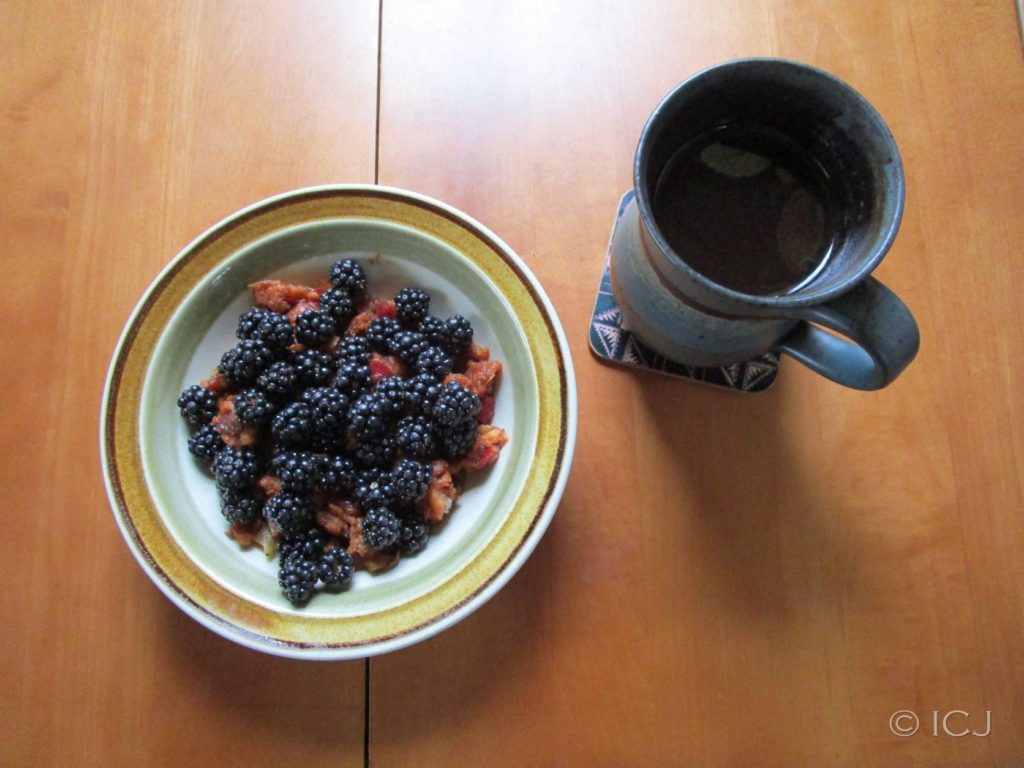
Snack #1: Apple Rings, Fruit Salad, Rose Hip and Cleavers Tea
Apple rings made in dehydrator last spring and kept in glass. They still taste great. Fresh strawberries, blueberries, and blackberries . . . nomnomnom. Little piece of heaven there. My big tea mug that fits both tea balls was dirty and doing dishes is a bit of a process here so I had two small cups of tea instead.
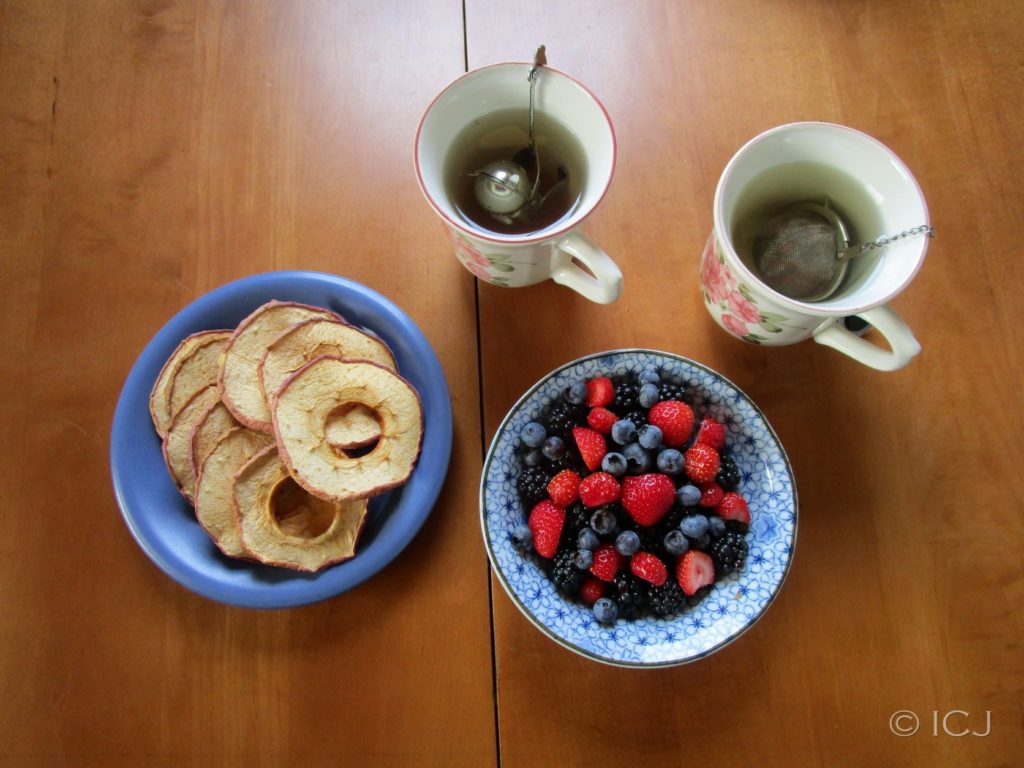
Lunch: Tabbouleh and Boiled Potatoes
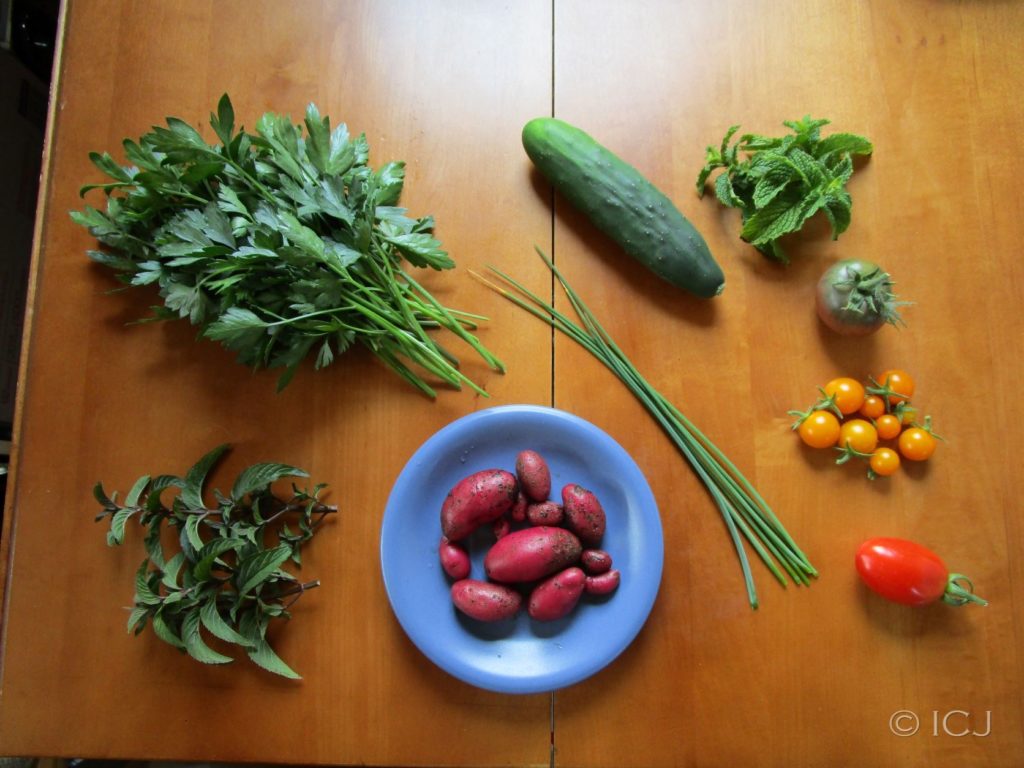
Homegrown food in August gets exciting. I started the parsley early from seed and moved it up into several gallon pots. Cucumbers and tomatoes reaching critical mass where I can harvest a portion every few days. The potatoes volunteered in the garlic bed, ones I missed from my meager harvest last year. They came out with the garlic mid-July. Small potatoes are better than none!
Tabbouleh made with olive oil and salt. Potatoes, too.
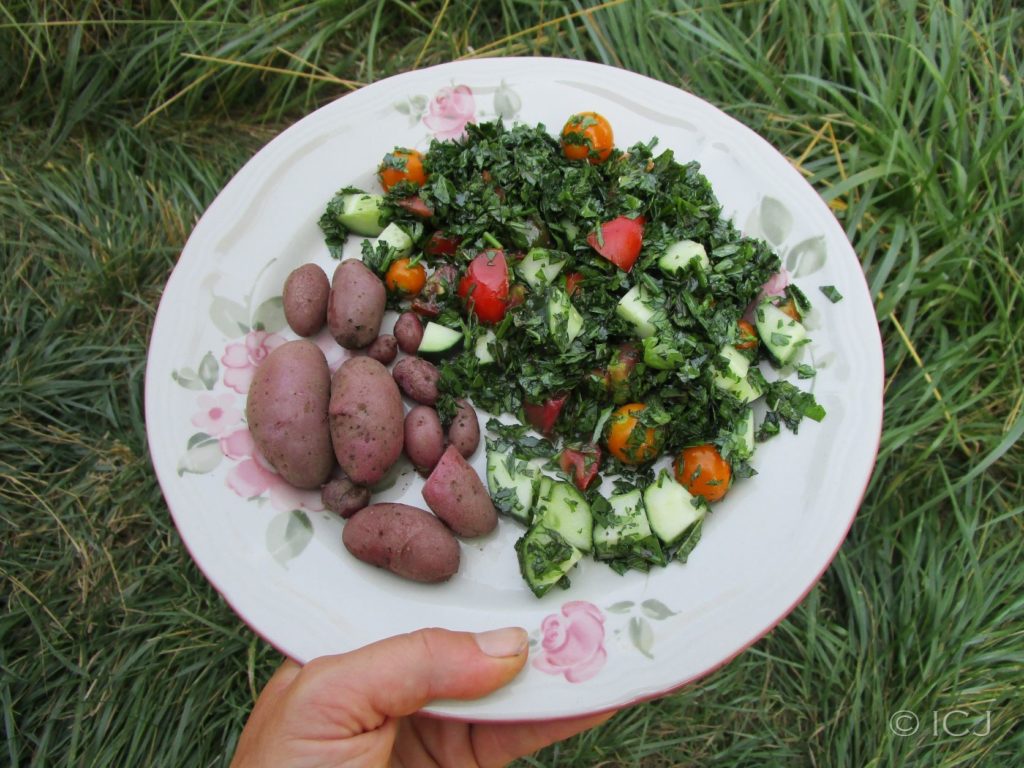
Snack #2: Watermelon
Just watermelon! Less than 10 minutes from vine to plate. So exciting to go out to the garden with pruning shears and cut it up and enjoy on the front steps on a hot summer afternoon.
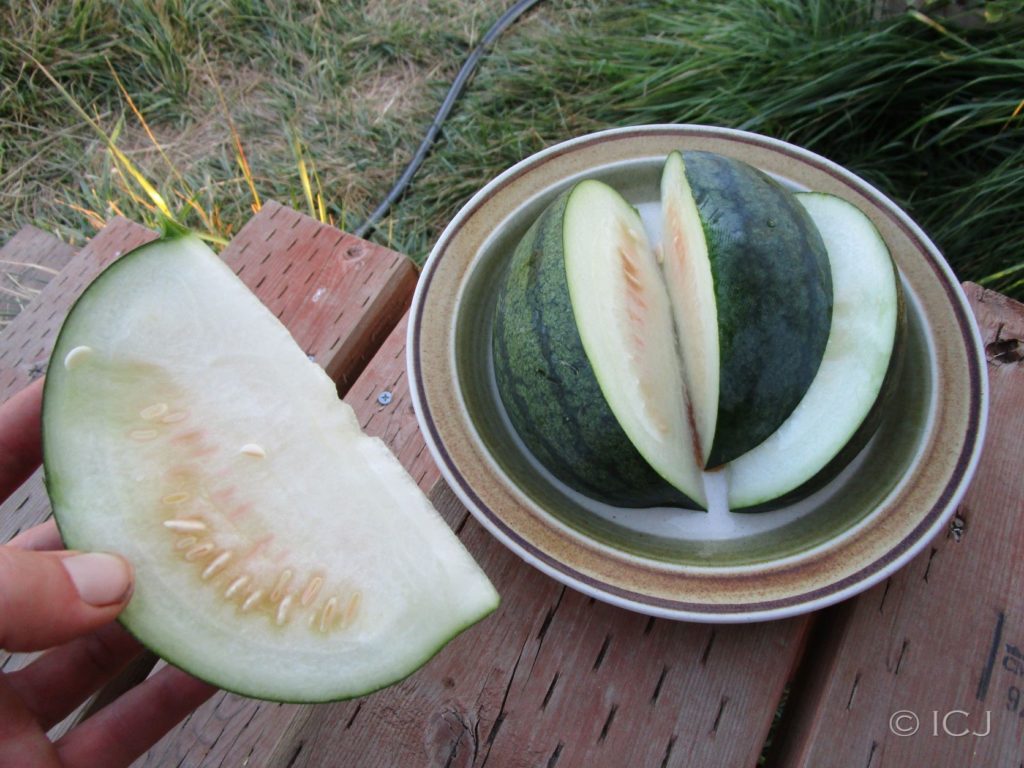
Dinner: Tromboncino with Pesto, Snap Peas
Homegrown pesto made back in July right after the garlic harvest, when the basil was at its prime. Convenient of them to coincide that way. I managed to keep it in pretty good shape through the heat wave by moving it to my porch where it gets afternoon shade. The basil lives in pots because last year when I planted a few seedlings in the ground as an experiment, they did not last the night.
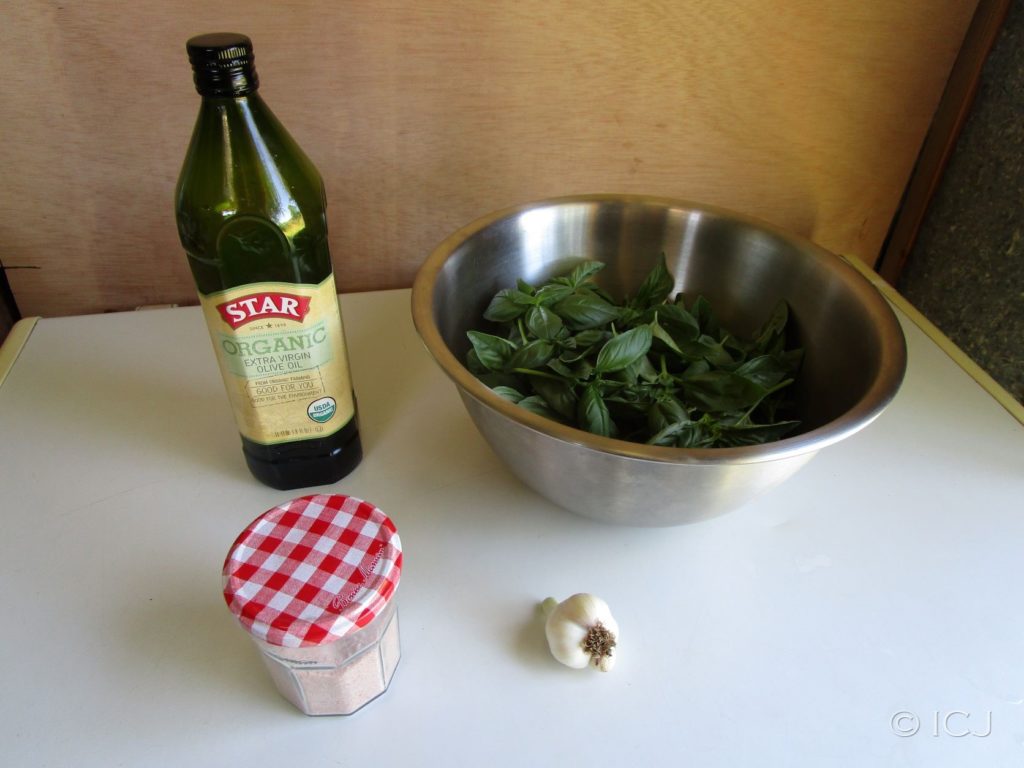
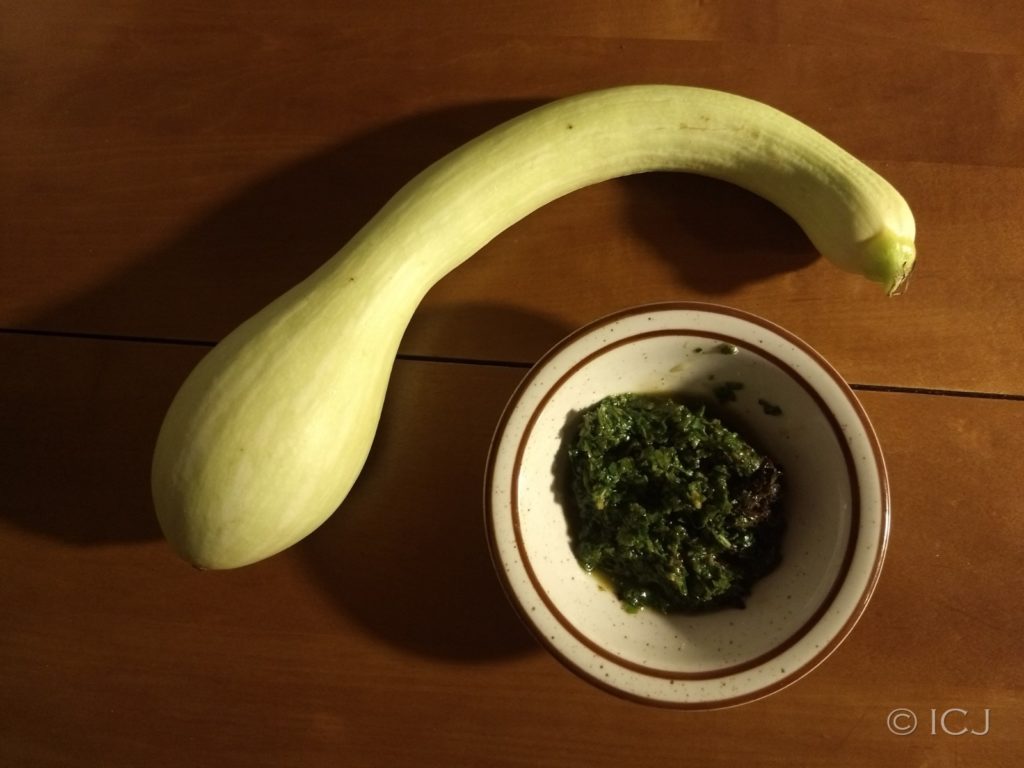
Tromboncino! An entertaining vegetable in the zucchini family with an equally entertaining name. It’s especially fun if you throw in some Italian emphasis. Tromboncino tastes like a cross between zucchini and spaghetti squash. I’ve roasted it whole before but this time I just boiled it in bite-sized chunks. Freshly thawed pesto on top, fresh snap peas on the side.
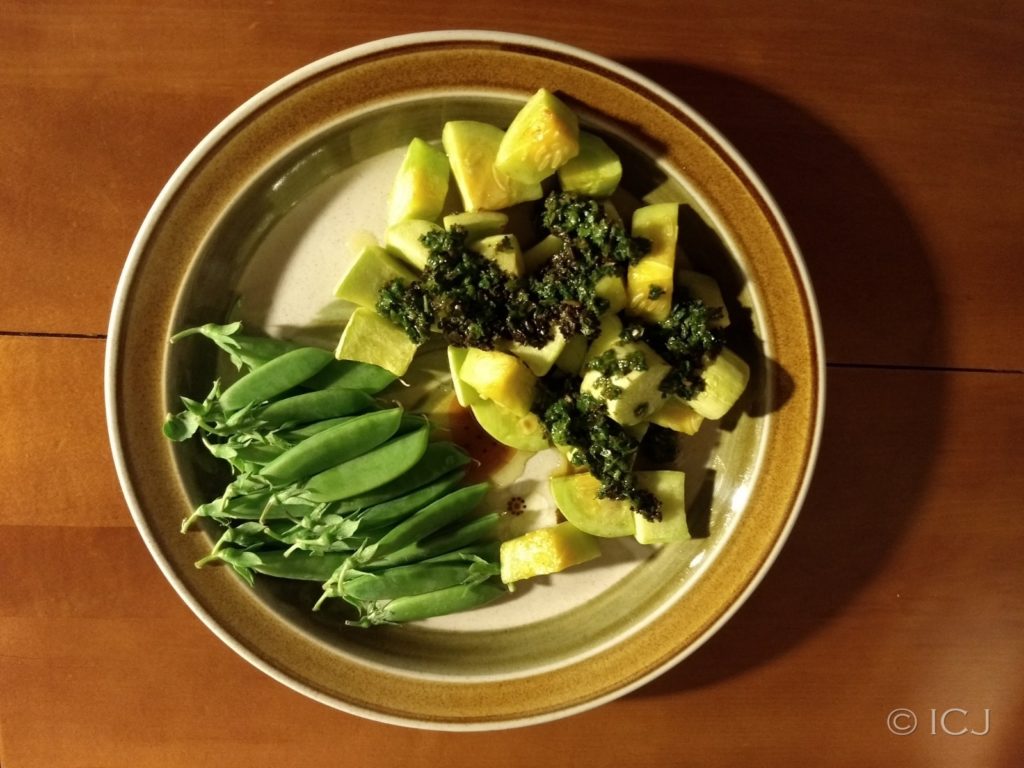
County Foodshed Day – August 14
Breakfast: Scrambled Eggs, Coffee
Eggs from Cryptid Creek, 100 yds away, cooked in butter.
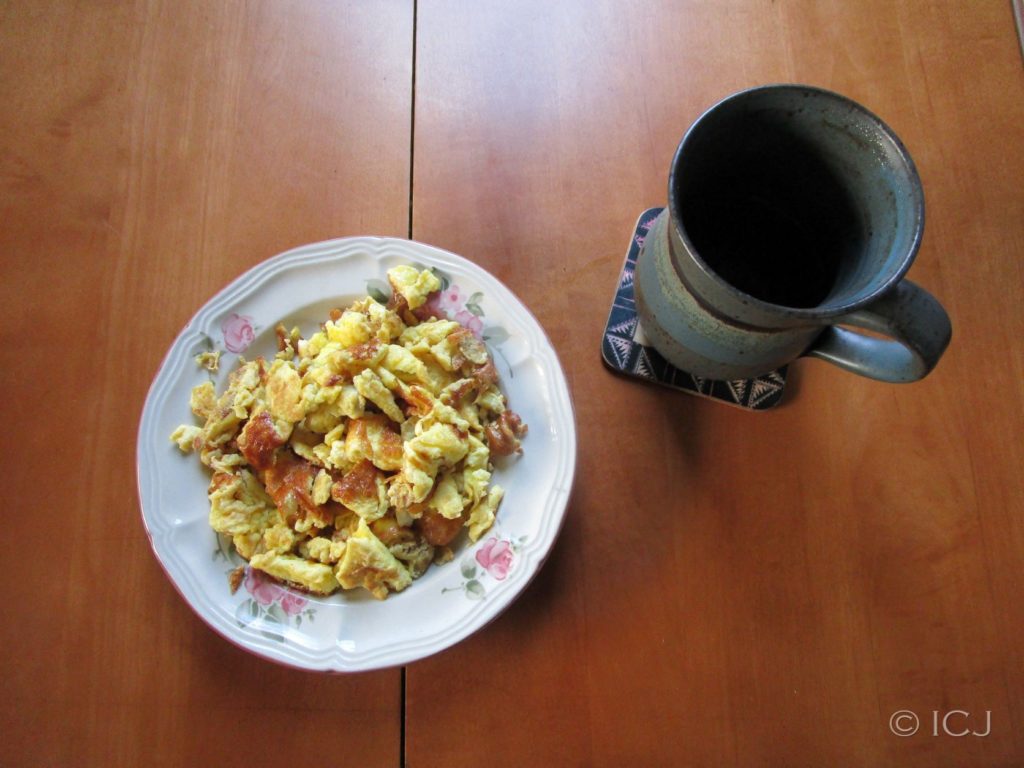
Snack #1: Smoothie
Apple mash (homegrown, thawed byproduct from last year’s cider-making process), blueberries (Aldrich, Mossyrock), blackberries (homegrown).
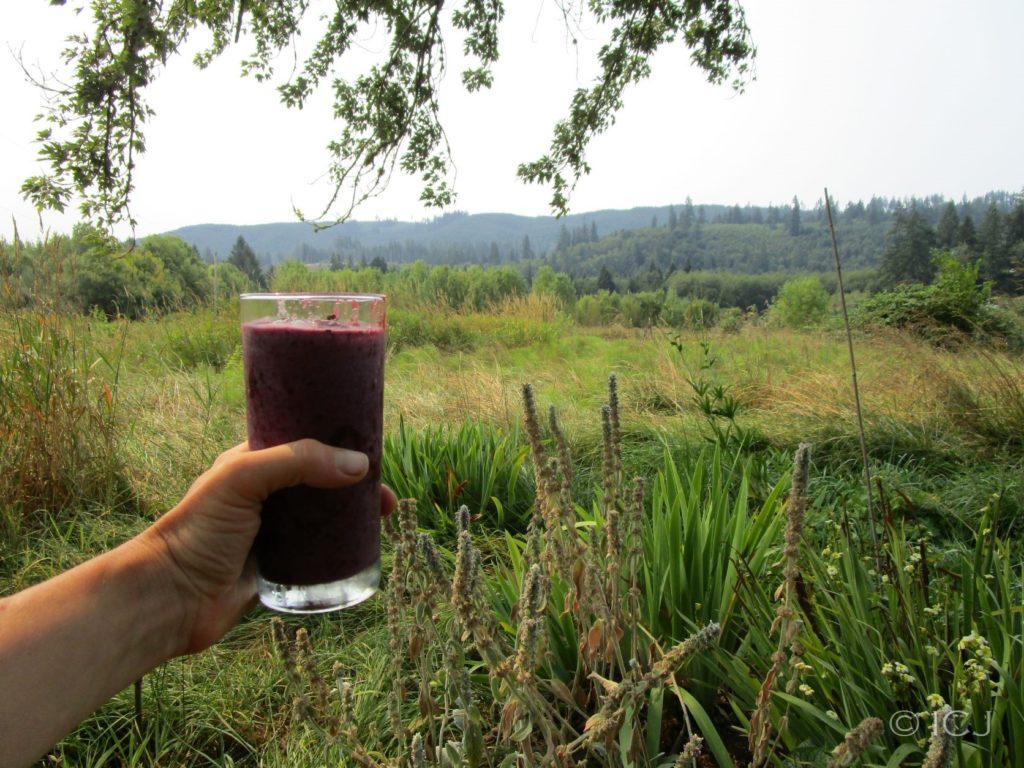
Lunch: Potato Salad, Watermelon
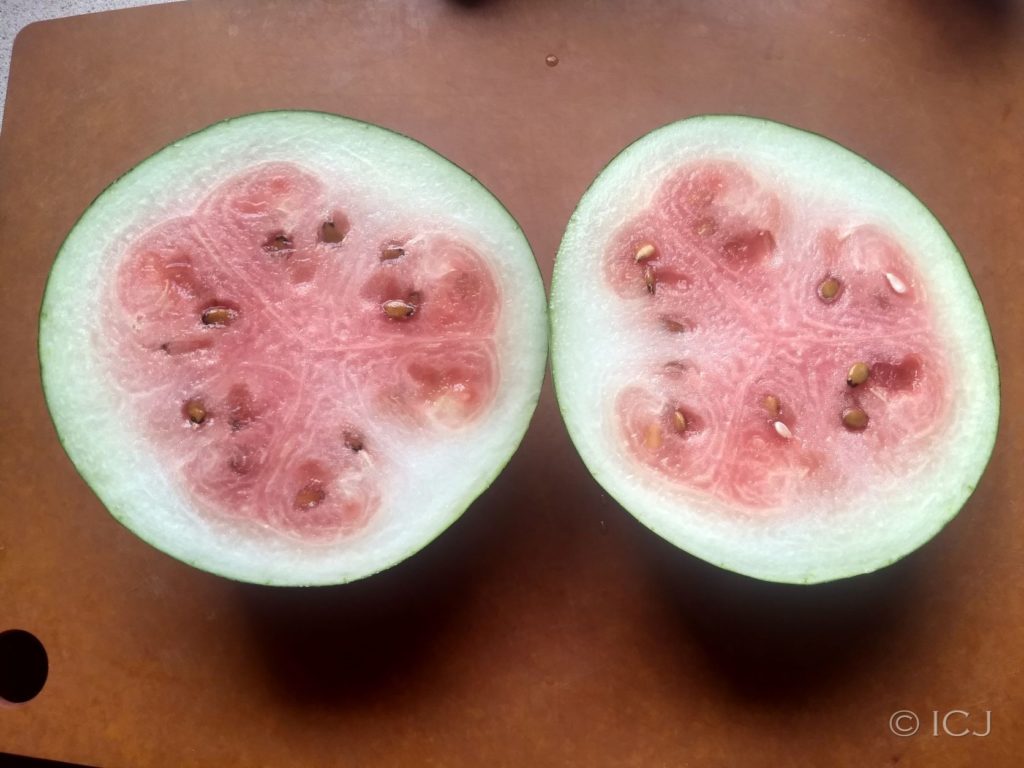
The second watermelon is red! I backed off on the watering and waited a little longer after it stopped getting bigger. Tasted about the same.
Boiled potatoes (Root Cellar, Onalaska), chanterelle mushrooms (foraged last October several miles northeast) sauteed in butter, ‘Sungold’ tomatoes (homegrown), pesto from homegrown basil and garlic plus olive oil and salt.
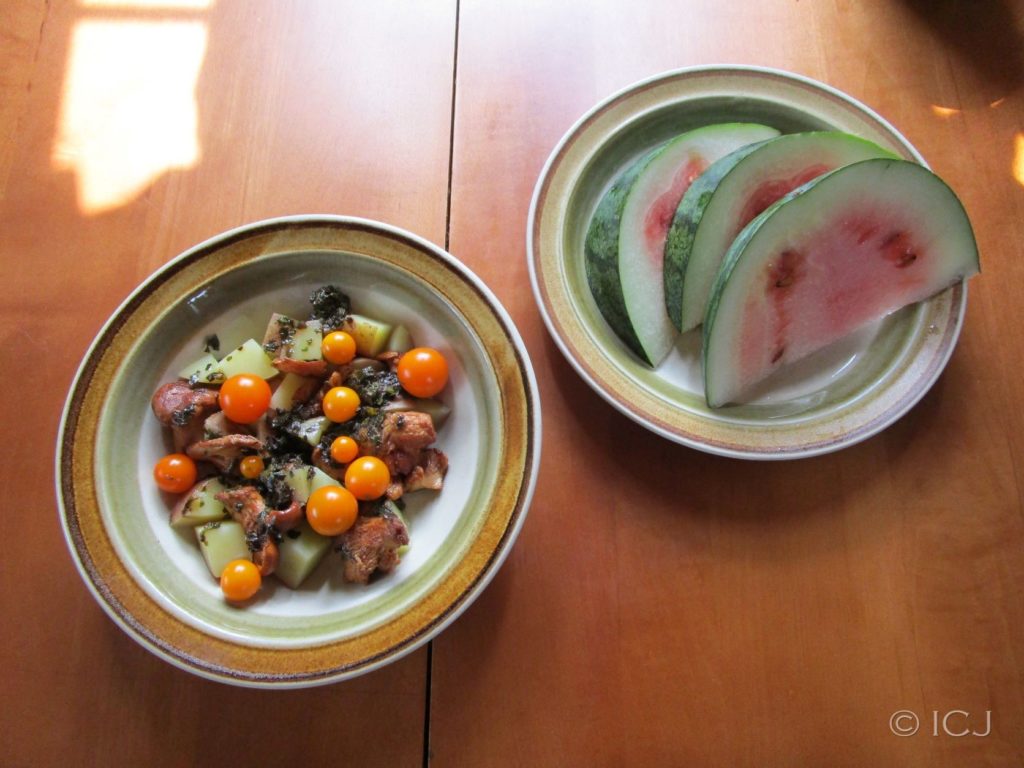
Snack #2: Chocolate Milkshake
Homemade ice cream = milk (Glenoma), eggs (Mossyrock), honey (Glenoma), vanilla, and salt. Add cocoa and buzz in the food processor for a few seconds. Yum.
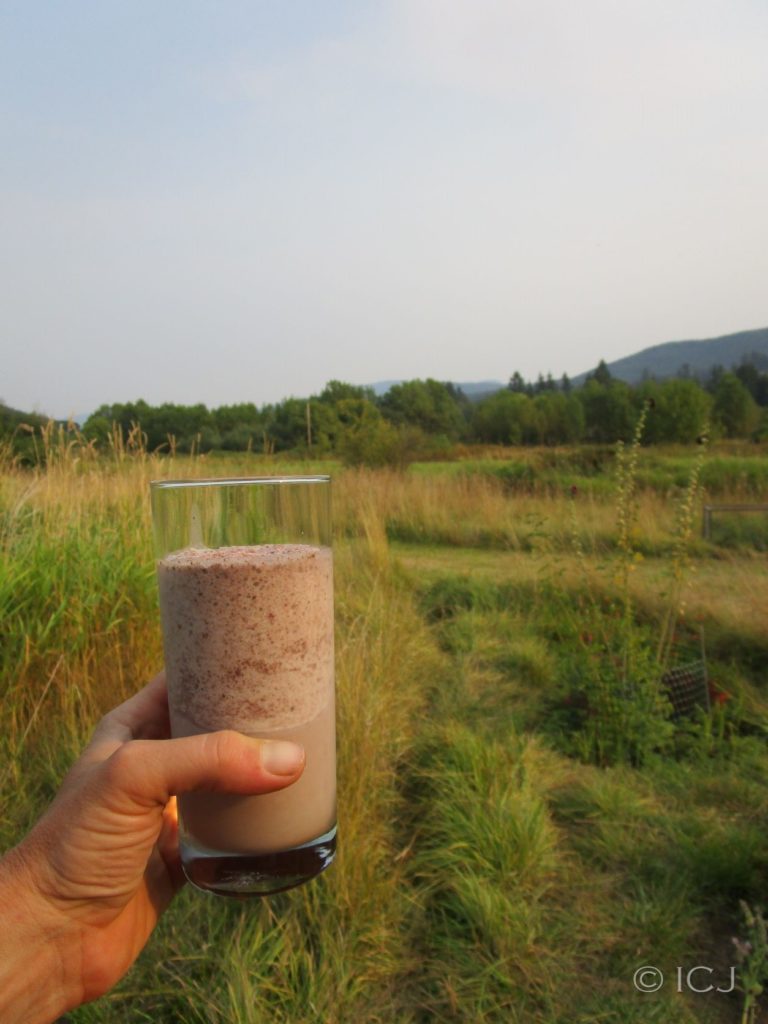
Dinner: Caprese Salad
Homegrown ‘Cherokee Purple’ tomatoes and cucumber on a bed of homegrown arugula with homemade cheese curds (milk from Glenoma, potions from Italy via Homesteader’s supply) and a drizzle of olive oil and balsamic vinegar on top.
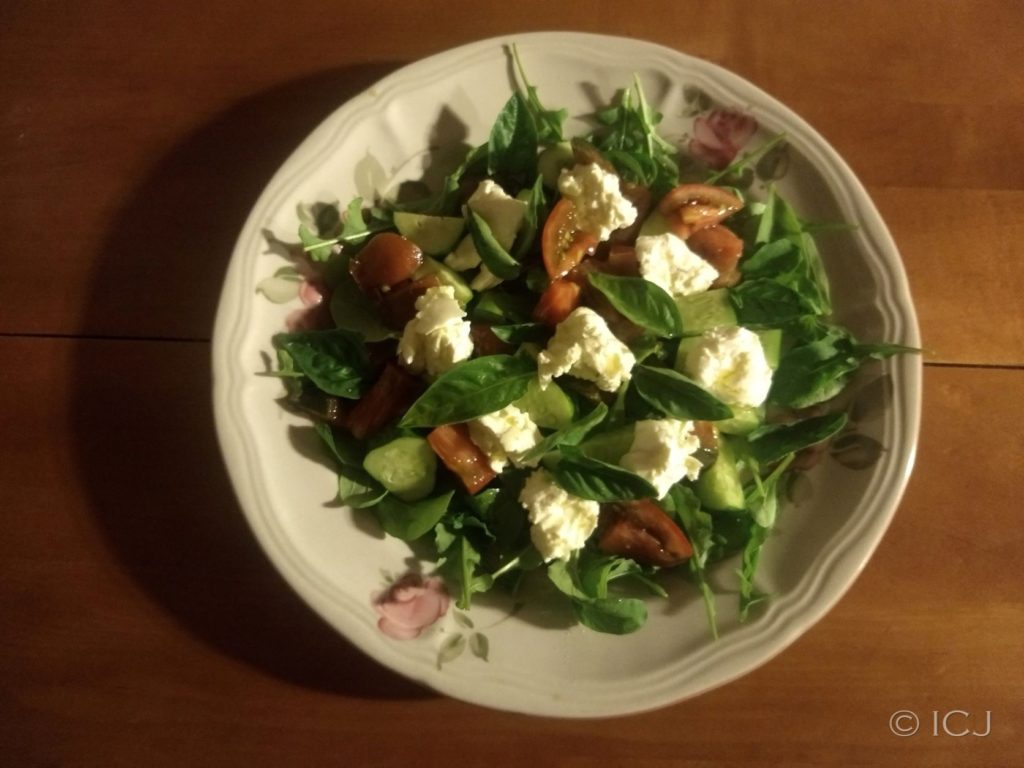
State Foodshed Day – August 28
Breakfast: Zucchini Pancake with Blackberries and Cantaloupe, Coffee
Pancake = egg (Cryptid Creek, Mossyrock), kefir (Grace Harbor Farms, Custer), zucchini (neighbor in Mossyrock), einkorn flour (Bluebird Grain Farms, Winthrop), honey (Beeworks, Bellingham), cinnamon, salt. Cantaloupe and blackberries homegrown.
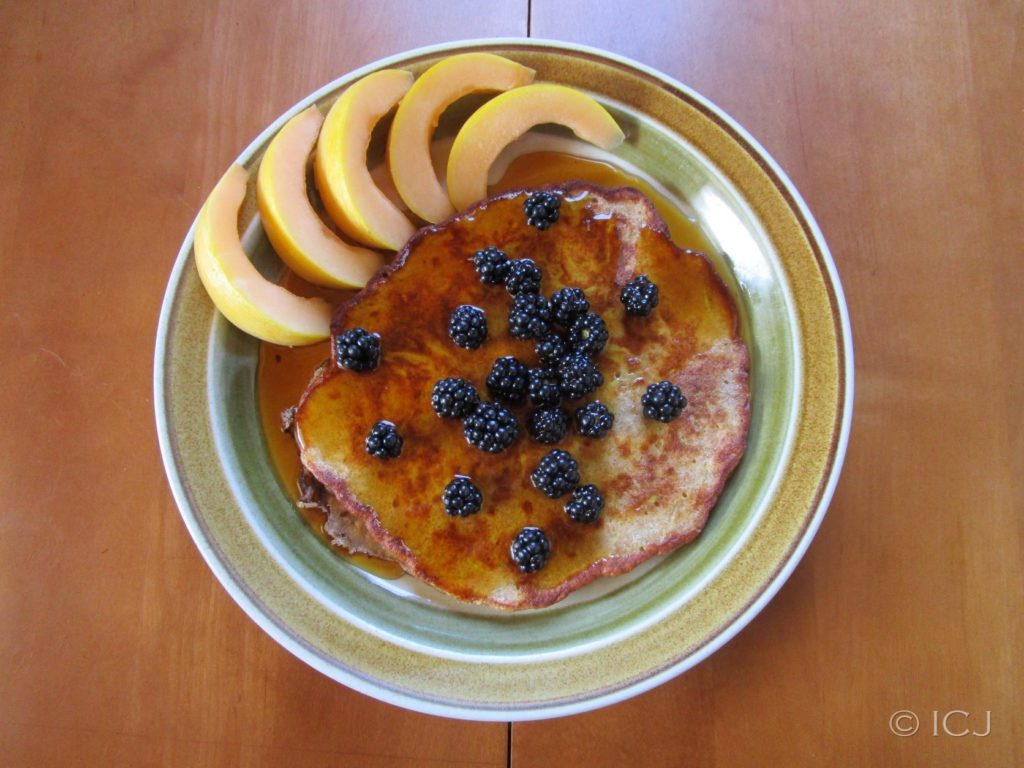
Snack #1: Zucchini Cake, Milk
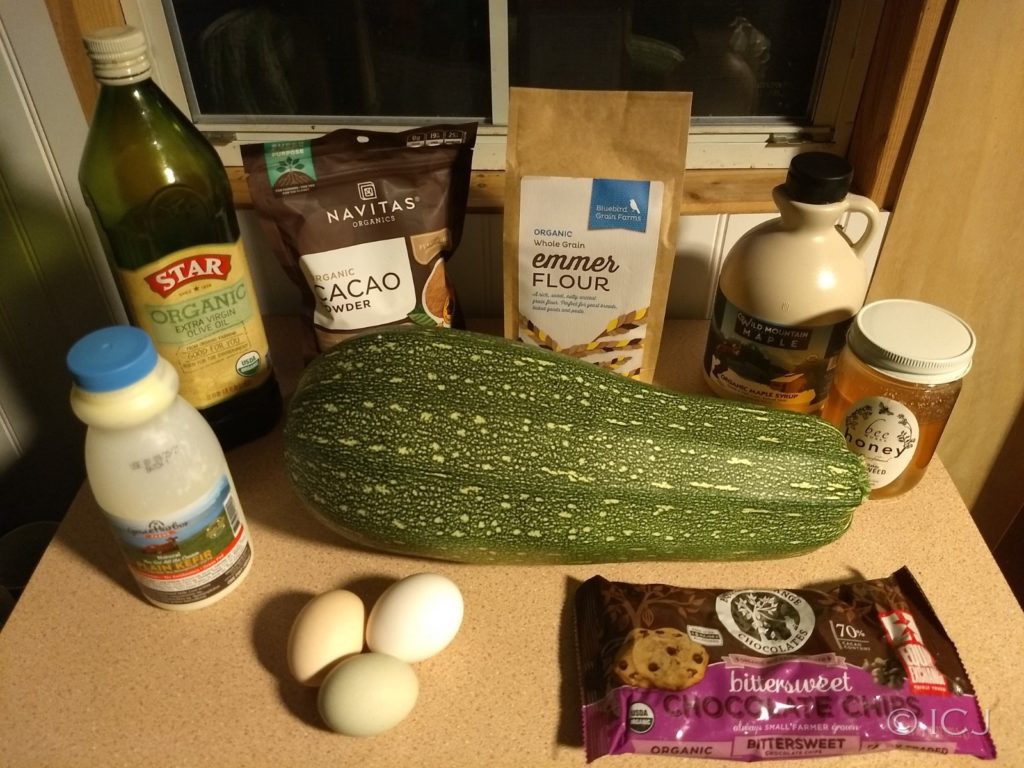
Cake baked the night before. Double chocolate zucchini cake is the best reason I can think of for zucchini to exist, though I enjoy it a number of ways. Pictured is the second giant zucchini my neighbor gave me. The cake was made with a portion of the first one, which was not quite as photogenic anymore after being used in a prior cake and several pancakes. This one weighed probably four pounds. The third one he gave me, which I have used to bake the 3rd and 4th zucchini cakes of season, weighed in at 5.4! Never have I encountered zucchini that were still this sweet at baking size.
Flour (Bluebird Grain Farms, Winthrop), honey (Beeworks, Bellingham), zucchini (neighbor in Mossyrock), kefir (Grace Harbor Farms, Custer), eggs (Cryptid Creek, Mossyrock). Olive oil, cocoa (Sierra Leone), maple syrup (Vermont), chocolate chips (Peru), salt, baking powder and soda, cinnamon, and cloves imported from outside WA.
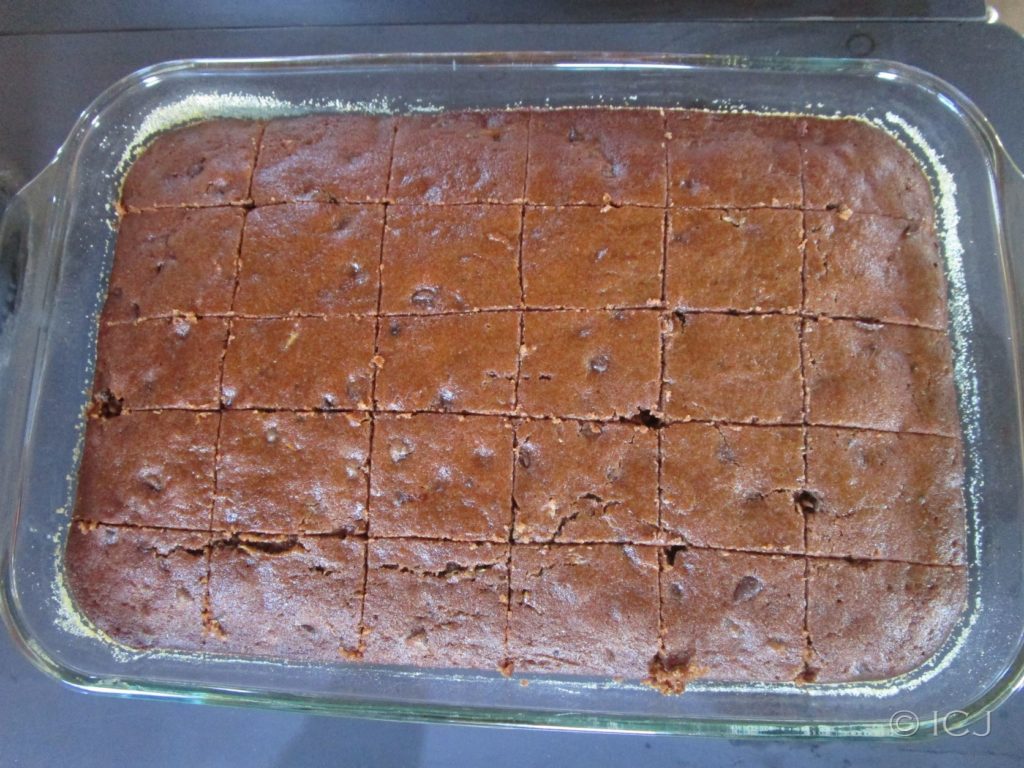
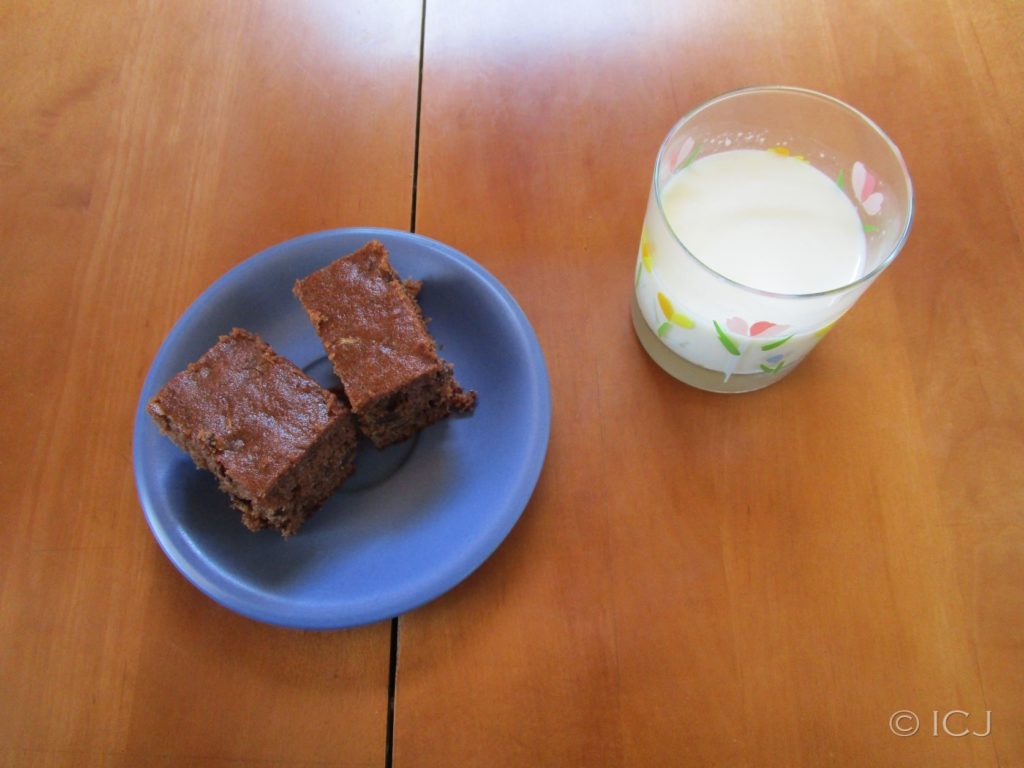
Lunch: Carrot Salad, Hardboiled Eggs on Greens, Bread and Butter, Hard Cider
I loved my mom’s carrot raisin salad as a kid. I’ve forgotten about it for years until recently. I now use plain yogurt or kefir instead of the mayo or Miracle Whip. No WA State grown raisins (yet–I plan to grow some) so I minced some homegrown-homemade blackberry apple leather and that worked rather well. Grated Carrots (Piece by Piece Farm, Olympia), kefir (Grace Harbor Farms, Custer).
Hardboiled eggs (Cryptid Creek) and spinach (homegrown) with a drizzle of olive oil and salt, Italian sourdough (homemade, left from WA State Foodshed day in July), butter. Cider from Tieton. The Hazy Strawberry is a little too sweet for my liking. I prefer their plain Organic which is the Goldilocks sweet spot between sweet and dry.
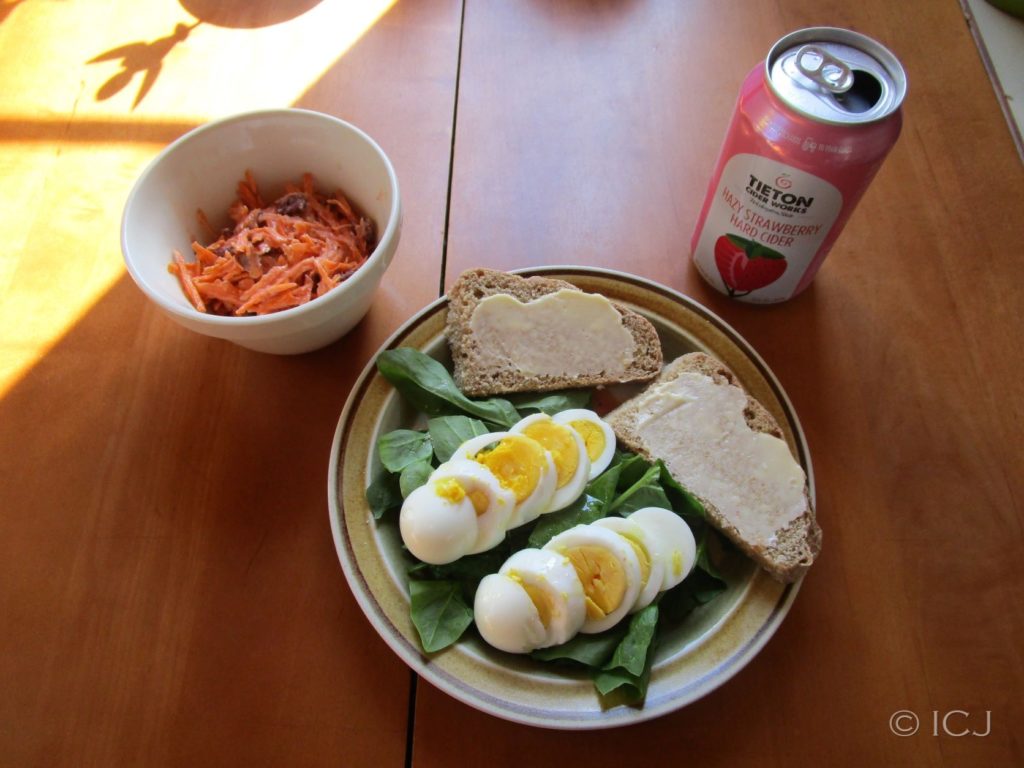
Snack #2: Ice Cream
Homemade ice cream using Lewis County ingredients. Milk (Glenoma), eggs (Mossyrock), honey (Glenoma), vanilla, and salt.
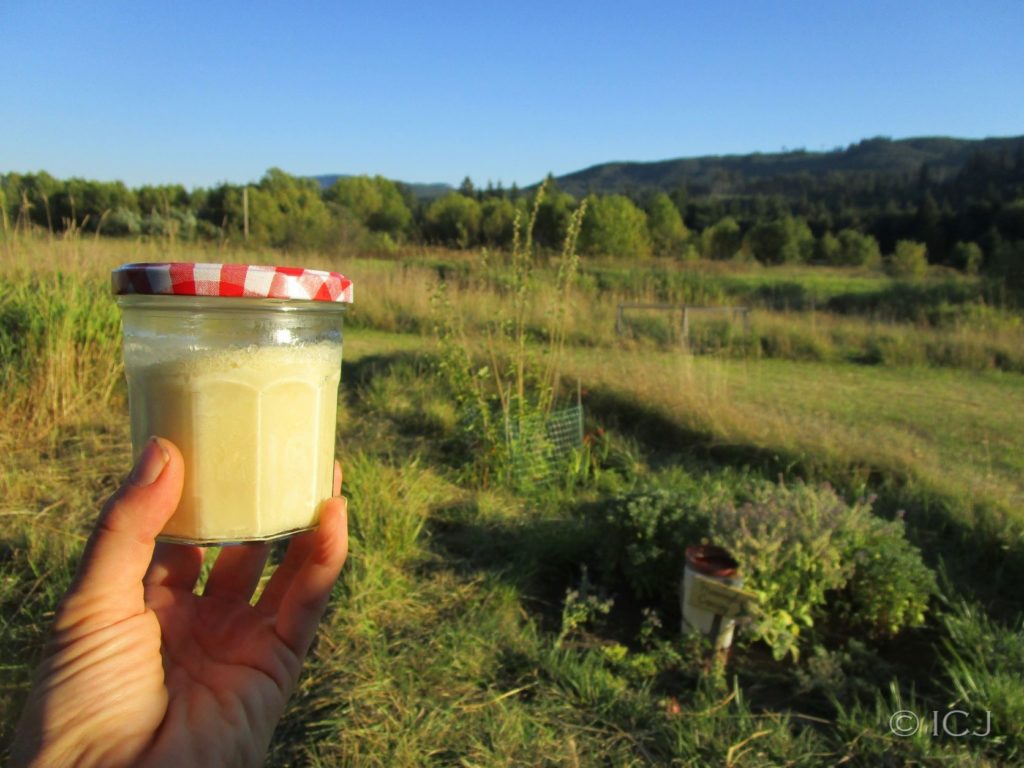
Dinner: Hodgepodge
Not quite a stir-fry. More of a warm salad. ‘Tromboncino’ summer squash (homegrown), elk steak (previously pan-fried and frozen), Cherokee Purple tomatoes (homegrown), and red bell pepper (homegrown) sauteed in olive oil and butter. Homemade fresh cheese curds (milk from Glenoma, potions from Italy) and homegrown basil on top.
